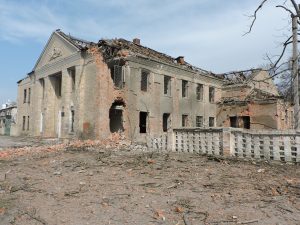By Serhiy Petrov
- Individual muscovite strikes on the northern outskirts of Kharkiv continue.
- There were no “traditional” midnight missile strikes on the city.
- The city has continued free use of public transport.
- Only a limited number of public transport vehicles are running, since a significant portion of the trams have been damaged, and passenger traffic in the metro has declined. The current daily ridership is 110,000, compared with almost half a million during the COVID quarantine.
- Work is underway in Pivnichna Saltivka to reconnect houses to the gas supply.
- Gas supply in the Malodanilivka Hromada, where the gas pipeline was damaged, has also been restored, and work is underway to reconnect the Derhachi gas supply.
- The occupiers and collaborators in the occupied territories are looking for teachers who will start using muscovite school programs in September.
- The occupiers have appointed a moscovia citizen as a gauleiter of the occupied Balakliya.
Individual muscovite artillery strikes on Kharkiv continue: there are occasional hits in the vicinity of Pivnichna Saltivka, Selyshche Zhukovskoho, and Pyatykhatky. There were no missile strikes on this day, which is good. The day passed in relative quiet overall. The only difference from the previous few days was that the number of air-raid alarms increased during the day. Weekend air-raid alarms have become a rarity in Kharkiv. Only a few weeks ago, they would go off a dozen times every day.
The picture in the northern suburbs of Kharkiv is different. Significant shelling continues in virtually all settlements controlled by our military, including Ruski Tyshky, Cherkaski Tyshky, Tsyrkuny, Pytomnyk, Nove, Ruska Lozova, Dementiyivka, Tsupivka, Prudyanka, Slatyne, and Derhachi. Two people were injured in the Kharkiv area overall. Once again, the village of Zolochiv was shelled, this time by shells with parachutes. Fortunately, no one was injured, but a number of residential buildings were damaged. Shelling continues in the northeast outskirts of the city, hitting the villages of Bayrak, Zamuilivka, Shestakovo, and Verkhniy Saltov; as well as in the Izium district, including the villages of Lebyazhe, Bazaliyivka, and Korobochkine. In the Malinovka township, three people were wounded by shelling. Also, four people were injured in the Chuhuiv area.

Fighting continues north of Kharkiv. We are attacking in some places and being attacked in others. The situation is more difficult northeast of Kharkiv, in the area around the villages of Bayrak and Rubizhne, where heavy fighting is taking place. The muscovites are trying to push our troops away from their supply route through Vovchansk to Kupyansk. They are trying to capture Shestakovo again and from there continue terrorizing the eastern outskirts of Kharkiv. The Ukrainian military has confirmed that they are keeping the situation under control, while advising residents not to return to the city just yet. Meanwhile, they are keeping the situation under control and are ready for a variety of developments. Kharkiv residents should not be worried, but they should also not neglect their own safety and the safety of their relatives and friends.
The overall situation in Kharkiv is stable, and it’s hard to talk about any big changes in the city. However, the number of people listening to loud music in the evening and having fun has increased. It’s hard to say whether these are people who had remained in the city all along or returned in May or June. This is a big change from earlier, when the city lived in quiet tension, like a stretched out spring. Also, in some places people sleep on benches during the day. Looks like they’ve done their exercise for the day and are now resting.
The city has decided to provide free metro and above-ground public transportation indefinitely. It is unknown how long this will last and will be decided later. Currently, 34 trams, more than 80 trolleybuses, and 74 buses run in Kharkiv. Almost all districts of the city are covered by the routes except for the dangerous ones, such as Pivnichna Saltivka and Selyshche Zhukovskoho. The decision to cancel the route to Selyshche Zhukovskoho was made after a bus carrying passengers came under fire, according to Yevheniy Vodovozov, the mayor’s infrastructure deputy. Thankfully no one was injured. (God, this is what I had warned about when public transport was launching in the city; it happened right after a shelling of the area that did have victims.) Meanwhile, some routes in Kharkiv are served by private carriers, whose fare is somewhere around 20 hryvnias. People have a choice: travel for free or to pay for the fare. Also the subway is now used by an average of 110,000 people a day. (During the COVID-19 quarantine passenger traffic was almost half a million.)
According to Ihor Terekhov, Kharkiv’s sister cities are working to help it with the purchase of transport vehicles, as there is now an acute shortage due to damage to a large number of public buses, trams, and trolleybuses—all a result of the shelling of Kharkiv. Purchase of electric buses is also being discussed.
Road workers are repairing roads, especially those damaged by shelling. This is happening in the safe eastern and southeastern suburbs of Kharkiv.
If the military situation permits, Kharkiv Mayor Ihor Terekhov plans to visit Madrid on 20 June to attend a forum dedicated to the post-war rebuilding of Kharkiv. The forum will be attended by Lord Foster, who is working on a new master plan for Kharkiv. Ideas for a new master plan will be presented at the event and then discussed together with Ukrainian, German, and Spanish architects. The rebuilding of Kharkiv will also be discussed with foreign investors.
An interesting rumor has begun to spread in Kharkiv, that according to someone who knows someone who works at the State Emergency Service, there’s potential for a cholera outbreak in Kharkiv. This is a classic case of a rumor being spread with reference to a third party. Meanwhile, Kharkiv residents have heard that tap water quality has fallen a little, and that there are pathogens in several springs in the city. I think this rumor was started by the muscovites in order to spread panic in the city and distract from the situation in Mariupol, where the probability of an outbreak of a number of diseases, including cholera, is high. It’s sort of a confirmation of the thought that war makes epidemics possible anywhere. I’m curious what rumors are being spread in Kharkiv and how, because psychological pressure and sowing panic as ways to strike at the spirit of the city’s residents continues.
Rebuilding work is underway in Pivnichna Saltivka to reconnect buildings to the gas supply.
It started after sappers had cleared the area of mines and after rescuers dismantled building sections that were damaged and could collapse. According to (gas provider) Kharkivmiskhaz, about 20,000 customers remain without gas supply in Kharkiv, most of them in Pivnichna Saltivka.
Law enforcement agencies including police, the Security Service of Ukraine, and prosecutors continue to document the effects of damage and destruction caused by muscovite shelling, missiles, and air strikes on Kharkiv and the suburbs since the beginning of the large-scale invasion. It is sometimes interesting to watch prosecutors inspect a place where we had worked more than two months ago, and where the destruction itself took place as far back as March. But it’s good that all the sites are being inspected by specialists.
There was a thunderstorm in Kharkiv in the evening and at night. It’s interesting to hear explosions along with the sounds of the storm. It’s an exercise in studying sounds. It’s not the best, but it’s what we have.
The Kharkiv youth symphony orchestra Slobozhansky held two charity concerts in Poland, collecting donations for the Armed Forces of Ukraine and rebuilding of the Karazin Kharkiv National University.
Gas supply in Mala Danylivka and the surrounding villages has been restored. It had been interrupted by damage of the main pipeline by muscovite shelling. Work is also underway to supply gas to Derhachi and other villages of the Derhachi Hromada.
According to Oleh Synehubov, head of the Kharkiv Regional State Administration, more than 1,700 people evacuated on 13 June from the occupied territories of Kharkiv through the Pechenizska Dam; about 700 of them were children. Ten percent of the evacuees are residents of the temporarily occupied territories of the Luhansk region.
On 15 June 15, one public transport route will be canceled in Kharkiv, another will be launched, and additional trains will be launched to run from Kharkiv to the suburbs and to Krasnohrad and Pervomayskyi.
On 12 June 2022, a cross was consecrated in the village of Pokotylivka, Vysochansk Hromada, and a stone was laid for future construction of a Temple of the Orthodox Church of Ukraine in honor of St. Ahapit of Pechersk. About 500 locals gathered for the solemn event.
Heavy fighting continues in the southeast of the region, in the Slovyansk and Barvinkove directions. Many frontline villages were shelled, in particular, the villages of Pokrovske, Pryshib, Chepil, Husarivka (of the Balakliya Hromada), and Dibrivne (of the Barvinkivska Hromada).
Roman Ratushnyi, a soldier from the 93rd mechanized brigade “Cold Yar,” who was a well-known Kyiv activist and fighter against illegal construction in the city, was killed in battle in the Izium direction. A couple of weeks ago he wrote, “The more Russians we kill now, the fewer will be left for our children to kill.”
And he was right. There was a map presented at the St. Petersburg Economic Forum in moscovia, showing administrative division of the territory of “former Ukraine” “liberated in the special military operation” during a transitional three-to-five-year period.
It depicted all of Ukraine, split into districts: Western (with Khmelnytskyi as the center) and Central (with Kyiv as the center), which would include the Kharkiv region. The muscovites have not given up on the idea of occupying all of Ukraine, up to the EU borders. This is their strategic goal, which they will never give up. And it does not depend on putin’s wishes—this is what the muscovites want. The war will last a long time, until moscovia is eliminated from its current borders. A military defeat at some point in time does not solve the problem. A new active phase of the war will break out in five, seven, or 10 years, when moscovia accumulates some forces and resources. And so it will be until moscovia is eliminated.
In the occupied Borova, the ruscists tried to find and re-erect a Lenin statue that was taken down in 2016. The search continues. Also, local collaborators in the Borivska Hromada are searching for teachers who are willing to teach using muscovite programs and who can run schools. In some villages where schools were damaged and destroyed, for example in Iziumske, occupation authorities told the locals directly that if they want schooling to resume, they should rebuild school buildings on their own and at their own expense..
Moscovia citizen Yuri Shevchenko was named gauleiter and so-called “head of the military-civil administration” of the occupied Balakliya. He took part in raising a tricolor cloth in Izium and called himself a “volunteer” while there. He also opened an office for “solving household problems” of residents, which is heavily guarded by the muscovite military. It looks like there were no willing and worthy gauleiter candidates among local collaborators.
Meanwhile, Lyptsi gauleiter Vadym Kydikov, head of the so-called “civil administration of Lyptsi,” a collaborator, and the Servant of the People party deputy to the Lypetsk village council, has written a letter of resignation from the party. The body of the text is written in Ukrainian, but the “It’s been an honor” sign-off is written in muscovite. I wonder why the Servant of the People party has not yet expelled him, considering that it’s been known for a long time that he is a collaborator. Questions, questions, questions…
The Eighth Administrative Court of Appeals in Lviv upheld a lawsuit filed by the Ministry of Justice to ban the Nashi political party, founded by ex-MP Yevhen Muraev. By the way, his wife, Valeria Muraeva, is a deputy of the head of the Kharkiv regional council. Funds and other assets of the party, its regional, city, and district organizations, primary branches, and other structural entities are transferred under state ownership. Muraev himself disappeared from public view at the end of February and is now said to be outside Ukraine. It is certainly good that another party was banned, but it would be good to also ban Opposition Platform for Life along with Opoblok. Many members of this party have become outspoken collaborators in the temporarily occupied territories of Kharkiv, Luhansk, Zaporizhzhya, and Kherson.
In moscovia, strange fires continue breaking out at industrial enterprises, and in Krasnodar, someone threw a Molotov cocktail at the regional department of the FSB.
In the occupied territories of Kherson and Zaporizhzhya, a movement of resistance against the muscovites continues. Leaflets against the occupiers are being posted.
Let us support the Defense Forces of Ukraine! Let us believe in the Armed Forces! Victory will be ours!




